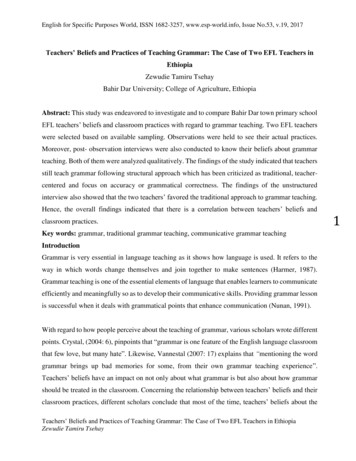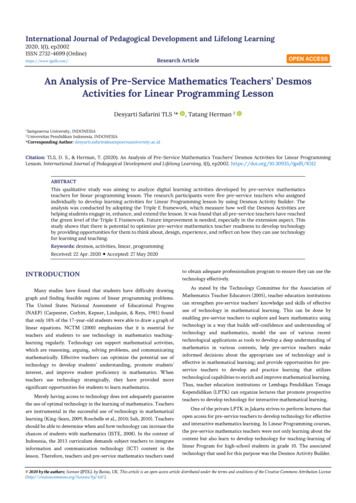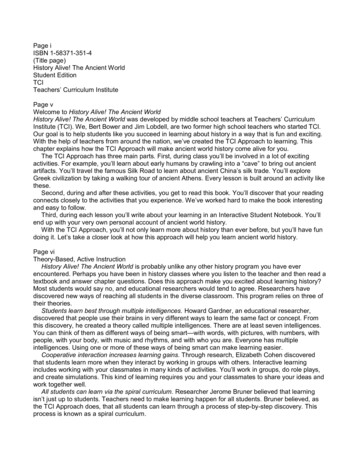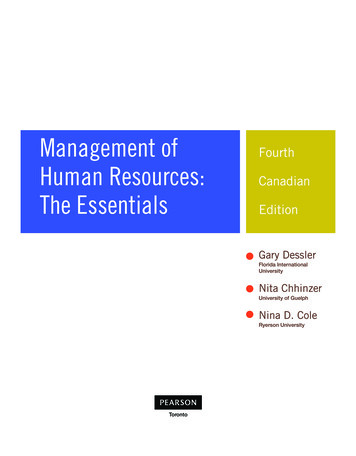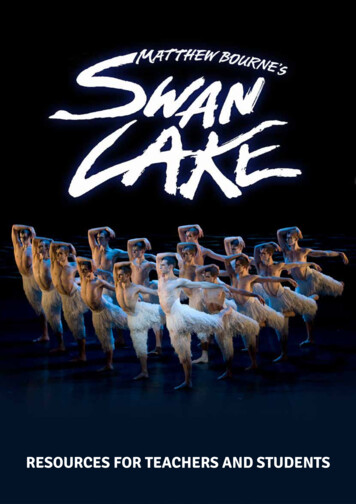
Transcription
RESOURCES FOR TEACHERS AND STUDENTS
CONTENTS1. OUTLINE OF THE RESOURCE PACKp032. THE PLOT OF SWAN LAKEp043. THE THEMES OF SWAN LAKEp06- The Royal Family- Paparazzi- Identity- Rejection4. THE CHARACTERS IN MATTHEW BOURNE’S SWAN LAKEp085. PRODUCTION ELEMENTSp11- Physical Setting Set Design Costume Design Lighting Design- Aural Setting6. THE ROLE OF THE CHOREOGRAPHERp207. WORKSHEETSp278. REFLECTING AND REVIEWINGp339. FURTHER WORKp35- Essay Questions- References- Resources and Further Reading- Reviews and Articles- CreditsMATTHEW BOURNE’S SWAN LAKE RESOURCES FOR TEACHERS AND STUDENTS2
1. OUTLINE OF THE RESOURCE PACKThis education resource pack aims toprovide an insight into the creativeand choreographic process of MatthewBourne in the development andreinvention of Swan Lake.The central focus of this resource is to provide workabletasks that address the key themes that Bourneresearched, as outlined in his choreographic notebooksand within interviews. Some of the themes explored inthis pack have been described by Bourne, others arethemes that might be identified by students or a SwanLake audience.The pack follows a structure which provides informationabout the dance itself, but also provides taskswhich encourage students to explore composition,performance and appreciation methods, the keyfoundation to dance work at key stage 2, key stage 3and at examination level at both key stage 4 and 5. Thefocus is on dance compositional tasks, an evaluation ofperformance skills, and research and analysis ideas thatwill encourage students to appreciate the dance on avariety of levels. That said elements of this pack will be ofuse to anyone with an interest in danceSymbols have been used to help differentiate betweenthe following; research and/or further reading activities,discussion and evaluation ideas, practical tasks and writtenwork. Clearly some of the activities overlap each other.The resource pack contains contextual information aboutthe work, the collaborators and the starting points forBourne’s realisation of Swan Lake, but also methods bywhich students will be encouraged to evaluate and gaina further insight into the analysis of a professional dancework. With this in mind the focus is very much basedon Performing Arts. The tasks and activities have beendeveloped to work within an education context, both forstudents and teachers and provide both discussion andevaluation tasks as well as practical dance ideas that canbe applied within the studio.Discussion and/or Evaluation IdeasResearch and/or Further ReadingActivitiesPractical TasksWritten WorkMATTHEW BOURNE’S SWAN LAKE RESOURCES FOR TEACHERS AND STUDENTS3
2. THE PLOT OF SWAN LAKEMuch of Bourne’s dance works areplot and narrative driven. He has apassion for developing characters andthen choreographically exploring theintricacies of how the characters relate toeach other.Although Bourne has a keen interest in traditional ballets,as seen within other choreographic works, he has afascination for making the narratives more contemporary,both in terms of dance vocabulary and content as well asmaking them more relevant to new audiences.This is the case with Swan Lake. Below is a brief outlineof the original Swan Lake narrative as choreographed byMarius Petipa to the Peter Ilyich Tchaikovsky musical score.PETIPA AND TCHAIKOVSKY’S PLOTThe original story tells of a prince named Siegfried anda princess named Odette. Odette is kidnapped by theevil sorcerer Von Rothbart, who turns her into a swan byday but allows her to return to her human form as nightfalls. The curse will be broken however when someonesacrifices their life for the Swan Princess or if a princedeclares eternal fidelity to her. It is on one night thatPrince Siegried, out hunting sees the beautiful Odettedancing in the moonlight by the lake and immediatelyfalls in love with her.Von Rothbart is furious and threatens to kill Siegfried butalthough this would free her from her curse, Odette stopshim. Seeing that a sacrifice will not work Von Rothbartdecides to trick the Prince into declaring his eternal loveto someone else. He takes his own daughter Odile intothe court and makes her look identical to Odette. ThePrince dances with her and proclaims to the court thathe wants to make her his wife. At that moment the realOdette appears outside the window and Prince Siegfried,realising his terrible mistake flees the castle to followOdette. She disappears into the lake and he pursues herthere. Unable to be wed in life, they are united in death.Von Rothbart’s power and his castle fall and the swanmaidens are set free and become human again.BOURNE’S PLOTBourne’s Swan Lake is a diverse work usingchorographic techniques taken from contemporarydance, ballet, social dance and mime. His emphasisis on the narrative as opposed to the dance itself. Hisreferences are many and varied, from the Royal family,characters from different 19th and 20th Century eras,to popular culture and films. Although the key narrativefocuses on the Prince’s life and his inability to fit intothe confines of the Royal family and his search foraffection and wanting to be needed, the piece is opento an individual interpretation and imagination givingthe audience a sense of being involved in the storyunfolding before them.Bourne’s Swan Lake was created in 1995 when the BritishRoyal family were in the spotlight. Obvious nods to thiscan be seen in the use of corgis, well known for beingthe Royal family’s favourite pet. However, it is certainlynot exclusively about the British Royal family. BourneJonathan Oliver. Production photo by Bill CooperMATTHEW BOURNE’S SWAN LAKE RESOURCES FOR TEACHERS AND STUDENTS4
noted that in his research he happened upon manyexamples of troubled royals over the years and across theworld. An example of this is Ludwig of Bavaria, a memberof the Wittelsbach dynasty, who became King of Bavariaat the age of 18. Ludwig was said to have an unhealthyobsession with swans. A lover of the theatre and music,especially that of Wagner, Ludwig became Wagner’spatron for a number of years. The King of Bavaria wascertified insane in his bedroom at Neuschwanstein and,a few days later, on 13 June 1886, he and his physicianwere found drowned in Lake Starnberg. Interestingly,many of Wagner’s works carried the theme of death asbeing the only true state where love and purpose couldbe found. A theme also suggested in Bourne’s finalimage in Swan Lake where, as the Prince lies dead onhis bed, the Young Prince is seen through the windowbeing carried away by the Swan. The insanity of Bourne’sPrince, a possible reference to Ludwig, is seen when thePrivate Secretary and the Queen keep him imprisoned ina clinical, white washed room.One question that many audience members ask iswhether the Prince is actually insane or if he is beingtricked by the sinister, ever-present Private Secretary.Although not sure of what the Queen’s right hand manwill gain from the death of the Prince, his betrayal isundeniable, bribing the Prince’s girlfriend to leave him;this serves to confuse the Prince when really she genuinelycares for him. One has to question whether the PrivateSecretary knows the Stranger that appears at the Ball. Ishe another attempt to tip the Prince over the edge?ACTIVITYWhat are the major differences between the plotsand what are the elements that make Bourne’sinterpretation more appropriate for a new audience?What elements of Bourne’s plot can you relate to asa member of the audience and what connections canyou see in our society?Richard Windsor and Christopher Marney. Production photo by Bill Cooper.MATTHEW BOURNE’S SWAN LAKE RESOURCES FOR TEACHERS AND STUDENTS5
3. THE THEMES OF BOURNE’S SWAN LAKEBourne states that his initial interestin Swan Lake was the interpretation ofmale swans, the representation of a royalfamily and the development of two majormale dancer roles.At the heart of Swan Lake is the narrative; engaging anaudience in a piece of dance theatre, rather than puredance. In updating the storyline Bourne addresses avariety of themes within Swan Lake, all to create an endproduct that is multi layered. As will be addressed laterwithin the pack, there are characteristics of Bourne’s workthat are acknowledged in Swan Lake as well as his othermajor works; the concept of love and hate, sexuality, thecomplexity of characters and their need to fit into society.THE ROYAL FAMILYWhen Swan Lake was created by Bourne in 1995, it wasa time of enormous interest in the Royal family and inparticular the young Royals. Although there are clearreferences to the duties of members of a generic royalfamily, there are also characters and situations that echoreal members of the Royal family. Bourne acknowledgesthat Sarah Ferguson, Duchess of York links to the role ofthe Girlfriend, particularly her inability to pursue Royaletiquette. Bourne also states that research into KingLudwig II of Bavaria influenced the development of thePrince’s character; his fascination with swans and hissexual confusion whilst trying to conform once again tothe expectations of being a Royal figure head.ACTIVITYWatch the opening section of Act One: Scene Two –The Palace and ask the students to identify each ofthe Royal duties that the Prince has to perform withinhis role as the public face of the Royal family. Alsoencourage the students to discuss how Bourne useselements of narrative drama by using performersto become objects and identify how movementtransitions are used to get from one duty to anotherand to different areas of the stage space.ACTIVITYIn groups of five, select three of the dutiesundertaken within the section that the studentshave seen or create some alternative tasks thata member of the Royal family might have toperform. Create a way of presenting each royalduty in turn where students become the public,objects as well as members of the Royal family.The focus is on transformation, reflecting thepassing of time and varied activities, as Bournedoes in his Royal duties section. Bourne uses awaltz step pattern as a key transition motif butset the challenge for students to explore differentways of travelling from one transition point andspace to another.PAPARAZZI AND THE MEDIAConnected to the theme of being a member of amodern Royal family is the idea of being a focal point,the centre of media interest. From an early stagewithin the work the Prince shies away and shieldshimself from the press and paparazzi that intrude intohis life. We see this particularly in the early stages ofhis Royal duties as well as when he exits from the club.ACTIVITYDiscuss the influence that the media and inparticular the paparazzi can have on influencingsomeone’s life. Diana, Princess of Wales maybethe most obvious example, show the studentsdifferent images that capture her on film indifferent situations and experiencing variedemotions. In groups of three research someonewho currently captures a lot of media attention andcreate a mood board using photographic imagesthat capture the different feelings and emotionsexperienced by that person, particularly the publicand private side of the person.MATTHEW BOURNE’S SWAN LAKE RESOURCES FOR TEACHERS AND STUDENTS6
IDENTITYThe theme of identity connects both the themes of theRoyal family and the media circus that can surroundsomeone who becomes famous, is thrown into thespotlight or becomes public property. Bourne has saidthat he combined aspects of members of Royal familiesthat were ‘not complete people’. We all have multiplesides to our own personality that make us unique andwe generally go on a life long journey discovering whowe really are and finding out our true identity. In SwanLake we join the Prince on his journey to find his trueidentity and this becomes a crisis at the end of the workwhen we see him treated as if he has had some kind ofmental breakdown. It is useful for students to offer aninterpretation of what they think has happened and why?ACTIVITYWhere else within Swan Lake is there a sense ofrejection, of characters not fitting in and charactersbeing pushed away?ACTIVITYSee Worksheet A: Exercise 6 for an extended taskbased on the theme of rejection and the two duetsbetween the Queen and the Prince.ACTIVITYACTIVITYUsing the character mood boards created fromthe paparazzi task as a stimulus, in the groupsthat created the work use the collage of imagesto choreograph a trio that reflects the multipleaspects of the person’s personality. The focus is onthe use of body posture and facial expression, keyrequirements of a performer in a Bourne work.Extension Task: Encourage students to showreferences to being captured on film by thepaparazzi, either by use of stillness, slow motion or arepeated motif. Choreographically set the task thatthe students have to use complementary movementas all three performers are representing one person.Also incorporate moments of unison within thedance when all three performers become one, as ifthey are working towards finding their true identity.REJECTIONIn Swan Lake as in many of Bourne’s work there is anabsolute focus on love and the need for love. The centreof this in Swan Lake is the Prince’s absolute craving foraffection. This theme is established early on in the work inthe Prologue when at the end of his nightmare the Queenoffers no physical support and rejects the Prince’s calls tobe held. Without the clarity that this rejection and lack ofaffection by his Mother is pivotal to the Prince’s insecurity,the audience would not understand the absolute need forthe relationship that he establishes with the Swan.Production photo by Bill CooperMATTHEW BOURNE’S SWAN LAKE RESOURCES FOR TEACHERS AND STUDENTS7
4. THE CHARACTERS IN BOURNE’S SWAN LAKESWANSThe replacement of the female corps de ballet in tutus withthe bare-chested, feathery legged, smudged black-facedmen, almost tribal in appearance, is the most obvious ofdifferences in this piece and for many the characters of theSwans are the most memorable aspect of the production.Bourne felt that the musculature, strength and poise ofa male dancer reflected more of the swans’ feral, roughnature than the delicate, fragile frame of a female ballerina.The traditional interpretation of Swan Lake focuses onthe elegance of a swan as it glides passively along thewater, the beauty and haughtiness of its long neck andthe romanticism that surrounds the creatures that havethe same partner for life. More often than not the elegantbeauty hides the truths that are forgotten about thesecreatures. Swans can be rather ungainly when away fromwater and very sinister, they are highly protective andconsequently aggressive; in fact there have been manystories of people with broken arms after a swan attack.Bourne wanted to combine all these qualities as well asbringing out the lyrical and emotional side of male dancingthat was rarely seen before. Bourne’s research includedstudying images and films of the creatures, reading aboutthem and observing them in their natural habitat.The Swans still act as a corps de ballet in that theyrepresent a group of swans but within the group there isindividuality as seen in the Big Swans and Cygnets withinAct Two: A City Park. In the ballet tradition a corps deballet would focus on uniformity, Bourne states that helikes individuality within performers, including physique,height and a dancer’s own style.ACTIVITYUsing either the motif description in Worksheet A:Exercise 5 and after watching the Big Swans sectionwithin Act Two: A City Park, either teach a motif,an extended section of dance vocabulary or get thestudents to recreate or capture the essence of someof the movements used by the Big Swans. Studentscan draw on the powerful qualities that are outlinedin the character description above. The Worksheetcan be used for the students to read danceterminology used within Bourne’s choreography andthen write their own version using dance vocabulary,with a focus on the action, space and dynamics ofwhat they have learnt or created.THE SWAN/STRANGERHere we meet the Odette/Odile character fromTchaikovsky’s original story. Yet there is no enchantedspell on a beautiful princess involved in this production.The Swan in Bourne’s version is a creature of the Prince’simagination. He is strong, beautiful, masculine, lyricaland sensual but also wild, dangerous and territorial;the leader of the Swan flock. To the Prince, the Swanrepresents the freedom and spontaneity that he wishesfor. It controls the Prince’s destiny and therefore inspiresthe Prince’s greatest fears and most secret desires.When commenting on the creation of the Swan, Bournehighlights a number of key points that allowed him tobring this creature to life. One way they tackled thedifference of being the Swan in Act One and a manin Act Three was to stop all facial expressions. Facialexpressions are a very human trait, stopping themcreates a blank canvas. It strips away the human andleaves the animal. The eyes and the movement is theonly way that the performer communicates withthe Prince.Another building block that Bourne added wasintroduced when faced with the famous and popularduets from the original ballet. Danced by PrinceSiegfried and his beautiful Odette in the original, Bournefaced the challenge of creating a duet for a man andPhoto by Lucy CullenMATTHEW BOURNE’S SWAN LAKE RESOURCES FOR TEACHERS AND STUDENTS8
a bird. The first obstacle came when Bourne (workingwith Adam Cooper, the original Swan), realised that theycouldn’t use lifts very successfully. Every time Cooperused his hands to lift it felt wrong. So the Swan’s ‘wings’were put to use instead. Lifts are undertaken by thewings going under the Prince’s arms, there is a lot ofwrapping of wings around the Prince and on a numberof occasions we see the Prince climb onto the Swan’sback as if to fly away with him.The Stranger is the alter ego of the Swan. As theStranger we see a dark, mysterious and glamorouscharacter. He has no social graces and sneers at Royaletiquette. He is fully aware of his sexual attractivenessand exploits this to the full. He is sly, cunning andmanipulative and will always end up getting his own way.ACTIVITYFind characteristics that clearly identify the Swan withthe role of the Stranger. Likewise outline what makeshim appear different in Act Three: Scene Two – TheRoyal Ball. Make a list of the character traits of theSwan and the Stranger to help draw out similaritiesand differences between the two characters.ACTIVITYA further practical task that draws on the characterof the Swan and the Prince and the challenge thatBourne had in representing their relationship can beseen in Worksheet A: Exercise 5.THE PRINCEThe Prince is a dreamer and always retreats into afantasy when real life becomes too difficult for him. Sincechildhood he has been fascinated by swans. Bournelikens the Prince’s obsession with these creatures to AlanStrang’s obsession with horses in Shaffer’s 1973 playEquus. As a boy he held a toy swan and took comfortfrom its softness and calmness but had nightmares aboutthe wild, unpredictable nature of a large and powerfulswan. As an adult Prince, he is weak and unstable, notsuited at all to the Royal lifestyle. He suffers in the role heis forced to undertake, finding the constant attention ofthe press unbearable. He is gullible and impressionable;sometimes confusing what is reality and fantasy as aform of escapism. His relationship with his Mother, theQueen is somewhat lacking in love despite his effortsof attention seeking. He is jealous of her young loversbut is too weak to ever challenge them or her on theirbehaviour. There is no father figure.ACTIVITYSet the students to research King Ludwig II ofBavaria and create ten key facts that they then haveto discover and share with each other to build up apicture of the King. In connection to Swan Lake, askthe students to state what elements of King Ludwig IIof Bavaria’s character and lifestyle Bourne has chosento use within the work.MATTHEW BOURNE’S SWAN LAKE RESOURCES FOR TEACHERS AND STUDENTS9
THE QUEENThe Queen is middle-aged but still retains her beautyand allure, of which she is immensely proud. She hasno husband so amuses herself with a variety of younglovers. She is a popular monarch and is fully aware of herRoyal responsibilities and executes them with efficiencyand grace. She is disappointed by her son’s weaknessand finds him irritating and embarrassing and a constantreminder of her own mortality. Outwardly she is cold andaloof with her son but with others she can be passionateand vivacious when it pleases her. Bourne wanted tomake this into a larger role as he thought that the motherwas an important role, not portrayed enough in theoriginal ballet. Bourne describes her as a manipulator,making the Prince into what he is. She gives him nothing,no affection, no love so he seeks it somewhere else.ACTIVITYYou will need a pack of playing cards. Using a queenplaying card as a visual guide, discuss the two headsthat are seen on the card. Could this represent thetwo sides of the Queen’s personality in Swan Lake?After discussing the idea of the public and privatepersona addressed within the Themes: Royal Familysection of this pack, ask the students to discuss whather characteristics are for each side of her personality.In pairs create a duet based on the Queen and theidea of two split sides of her personality; publicand private. The duet could explore the devices ofmirroring to echo the duality of her character andopposition or contrast in both her movement styleand dynamics, to highlight different character traits.Richard Windsor and Dominic North. Photo by Hugo Glendenning.THE PRIVATE SECRETARYIn this version of Swan Lake there is no evil Von Rothbartbut there is the Private Secretary. His role is as adviserto the Queen, a scheming character who is tryingto engineer the Prince’s downfall but is outwardlytrustworthy and reliable.Private Secretary costume design by Lez Brotherston.MATTHEW BOURNE’S SWAN LAKE RESOURCES FOR TEACHERS AND STUDENTS10
5. PRODUCTION ELEMENTSAs mentioned previously within thispack students at examination level areencouraged to analyse dance work usingthe constituent features of a dance; thephysical setting, which incorporates set,lighting, costume and props, the auralsetting, the movement, the dancers andthe form and structure of the dance.In this next section we will take a closer look at some ofthe elements that make up the physical and aural setting.Bourne is a keen collaborator when creating his workboth artistically when looking at the whole productionand when working choreographically with his dancers, aswill be discussed in the following section.In terms of the collaborators Lez Brotherston was the firstperson to contribute to the design and in turn the artisticand choreographic vision. Bourne did not want to createa specific country or place or limit the time period either,this has meant that in his words Bourne in partnershipwith Brotherston has created a ‘kaleidoscope’ that movesfrom different worlds and different time periods.In addressing each element of Swan Lake and thecollaborators that have contributed to the work, there ispotted biography and then some key information aboutthat element of the work and some further tasks andactivities.PHYSICAL SETTINGLez BrotherstonSet and CostumeDesignerLez trained at CentralSchool of Art andDesign. He is anAssociate Artist ofNew Adventures.Dance credits include a long collaboration with MatthewBourne resulting in: Dorian Gray, Swan Lake, HighlandFling, Cinderella, The Car Man, Play Without Words,Edward Scissorhands and Lord of the Flies. Lez has mostrecently designed Seven Deadly Sins (Royal Ballet); IntoThe Woods and The Soldier’s Tale (ROH 2). He designed,co-wrote and co-directed Les Liaisons Dangereuses withAdam Cooper (Japan and Sadler’s Wells). For NorthernBallet: Romeo and Juliet, Swan Lake, A Christmas Carol,Carmen, Hunchback of Notre Dame, The Brontësand Dracula.Theatre credits include: A Long Day’s Journey Into Night,Under The Blue Sky, In Celebration, Dickens Unplugged(West End); My City, Measure For Measure, A Dark DarkHouse, Dying for It (Almeida Theatre); The Day We Sang(Manchester International Festival); Women BewareWomen, Really Old Like 45 (National Theatre); DesignFor Living, The Real Thing, Dancing At Lughnasa (OldVic); Duet For One (West End and Almeida); HeddaGabler (The Gate, Dublin); Much Ado About Nothing(RSC); The Dark and Little Foxes (Donmar Warehouse);Musical credits include: Sister Act (West End, Broadway,Germany Vienna, Milan, Holland); The Rise And Fall OfLittle Voice, Acorn Antiques, Far Pavilions, Spend, Spend,Spend, Tonight’s the Night, My One and Only, SpendSpend Spend (West End).Film credits include: Letter to Brezhnev, Swan Lake,The Car Man, Romeo and Juliet and A Christmas Carol.Opera credits include: L’Elisir d’Amore andCornet Christoph Rilke’s Song of Love and Death(Glyndebourne) and productions for Opera North,Scottish Opera, Opera Zuid Holland, Welsh NationalOpera, Royal Danish Opera.Other: Victoria Wood – At It Again 2001 (Royal AlbertHall & tour) and French and Saunders Live in 2000 (UKtour) and French and Saunders – Still Alive 2008(UK tour).Awards include: a Tony Award, Outer Critics’ Circle andtwo Drama Desk awards for Swan Lake (AMP), eightOlivier nominations, winning an Olivier for OutstandingAchievement in Dance for set and costume forCinderella and the Critics’ Circle Award for OutstandingAchievement in Dance.MATTHEW BOURNE’S SWAN LAKE RESOURCES FOR TEACHERS AND STUDENTS11
SET DESIGNSwan Lake was designed for proscenium arch theatres. Fourlarge white columns stand left and right of the stage throughoutthe entire performance. A white breezeblock wall standsupstage throughout the Palace scenes and the entire structureor sections of it can be flown out when the action movesoutside the Palace. The vast amount of white used throughoutthe production seems to suggest a cold, clinical environment,lacking in warmth, colour and love.Different locations within and outside the Palace areachieved with simple scenic changes.The centre of the whitewall can be raised, the Young Prince’s bed, that we see atthe very beginning can be turned 180 degrees and thenpushed back into the space in the wall. The back of the bedhead is draped in a red cloth decorated with a gold crownwhich turns it into a Royal balcony from which the familywave down to their subjects. Later on in Act One, the bed/balcony disappears altogether and the gap in the back wall isnow filled with the appearance of a large gold crown flown inabove the performers as a red carpet is rolled out down themiddle on which the Queen and the adult Prince enter.Act One: Scene Three – An Opera House, takes us to astage within a stage. Here Brotherston utilises anotherpiece of flying set; a large proscenium arch slightly askewto suggest the fakery of it. A Royal Box is stage left ofthis. Within our fake theatre a painted backdrop of agothic castle bordered by trees is our setting for thepastiche ballet, a love story between a moth maiden and awoodcutter.The Seedy Club in Act One: Scene Six is the most vividlycoloured of the show so far. Pink ruche curtains are drapedalong the back, creating a back drop, a bar upstage rightJonathan Oliver and Dominic North. Photograph by Bill Cooperwith a podium upstage centre house the dubious andrecognisable characters of the 1960’s and 1970’s. A vividpink neon sign hangs above the bar.As the gauze curtain rises for Act Two a mist hovers above thestage. We are in a park. Bare-branched trees stand upstageof the four pillars cartoon-like stretching out like long graspingfingers. A streetlight, park bench and waste bin are downstage right; all three are removed for the core of Act Two andare replaced at the end of the act. A notice attached to thestreetlight warns ‘Do Not Feed The Swans’. A full moon hangsabove us.ACTIVITYIn pairs encourage the students to sketch out analternative set design for any of the scenes withinSwan Lake. Encourage the students to considerwhat the set may have to do for the scene they areconsidering; identifying location, may need to providespace for the dancers, provide a period of time, offer asupport or varied levels etc.School boy xcostume design by Lez Brotherston.Extension Task: This could be developed so thatstudents have to create a 3D version of their designsMATTHEW BOURNE’S SWAN LAKE RESOURCES FOR TEACHERS AND STUDENTS12
using an old box to represent a proscenium arch stageand ensuring that the design incorporates a backdropor cyclorama, wings and set that can be flown in.COSTUME DESIGNSwansThe Swans hair and upper body are covered in whitemake-up. The eyes are highlighted in black as well asa triangle of bla ck from the crown of the head to thebridge of the nose suggesting the markings on a swan’shead and beak. They wear a deep-welted pair of kneelength pantaloons, the white fabric slit to suggest aswan’s plumage. They are bare foot.long sleeved, full-length dressing gown to the stunningblood red satin ball down in Act Three. All are striking,breathtaking and regal as the Queen promenadesaround her subjects with a grace of a 1950’s Hollywoodfilm star.The Ballet CostumesThe pastiche ballet in Act One: Scene Two seesBrotherston using the old Romantic period ballet style,with the Moth Maiden in a calf length tutu. Two of theButterfly Maidens wear mid-thigh yellow tutus while theother two wear lacy, black thigh length shorts.The Wood Cutter (our hero) wears green lederhosen,a white billowing sleeved shirt, white tights and greenboots. He also wears a comedy moustache and whiskers.The Troll and Trollettes wear full head masks andmottled brown unitards. The Troll has hairy pantaloonsand a codpiece with warty, spiky protrusions. All threecharacters have long rubbery fingers.The Seedy Club SceneA seedy club full of scandalous characters from the 1950’sand 1960’s is a fantastic arena for a fashion parade inAct One: Scene Six. From Ea
MATTHEW BOURNE’S SWAN LAKE RESOURCES FOR TEACHERS AND STUDENTS 2 1. OUTLINE OF THE RESOURCE PACK p03 2. THE PLOT OF SWAN LAKE p04 3. THE THEMES OF SWAN LAKE p06 - The Royal Family - Paparazzi - Identity - Rejection 4. THE CHARACTERS IN MATTHEW





